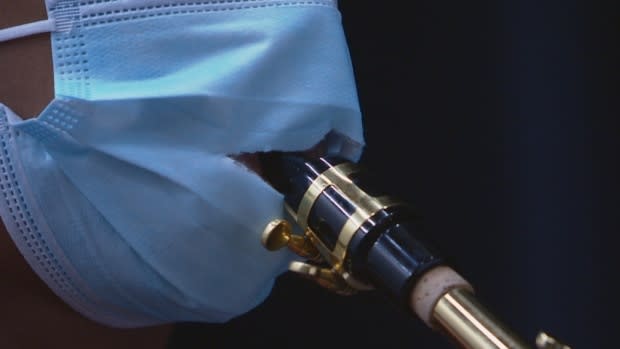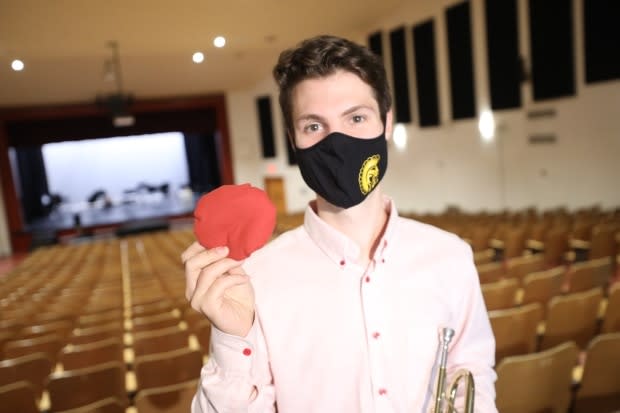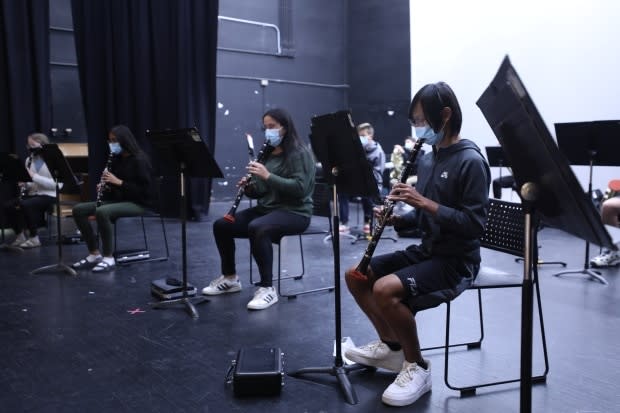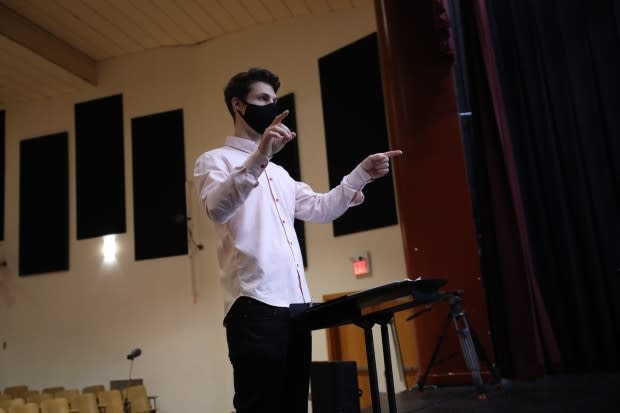The sound (and science) of music: School bands adapt to COVID-19
Students in a Regina high school band class say the simple act of playing music together gives them a sense of normalcy, despite major changes to the way schools are run in the era of the COVID-19 pandemic.
"I love playing music. It just feels like home, I guess," said Aiyana Yowin, a Grade 9 student at Sheldon Williams Collegiate.
Students rehearse inside a large auditorium, sitting two metres apart. They all face forward and blow into their brass and wind instruments through holes cut in disposable surgical masks. Those instruments — including clarinets, trombones, tubas and saxophones — also have masks over the end where the sound comes out.
Across Canada, many students still aren't allow to sing or play certain instruments inside school. Federal public health guidance notes that research continues to evolve, and that wind and brass instruments have a "theoretical possibility of increasing the transmission of COVID-19, but the risk is not fully understood." It recommends some precautions to limit the production and transfer of infectious respiratory droplets.
In July, Saskatchewan gave orchestras and bands the greenlight with a few restrictions, but it's mostly up to school divisions to figure out how to resume in-person band class safely. In Regina, eight out of nine public high schools are running band, choral and instrumental courses.

Band director Brady Frank enlisted his fiancée to fabricate bellcovers — the masks for the instruments — with a filter inside that he said prevents 80 per-cent of droplets from getting out of the instrument bell.
"With the cotton on there as well, it's actually quite protective. More protective than a regular facemask that someone would make at home," he said.
The class only plays for 30 minutes before leaving the auditorium for an hour to allow for clean air exchange. Students learn theory in a smaller room during that time, then return to rehearse for another half hour.
"At the very start it was kind of … strange to be playing music in the same room together," said Frank. "It's so nice to play with other human beings."

Return to band based on preliminary research
Frank and other Regina band teachers he met with over the summer were searching for more detailed guidance. So, like other music teachers in Canada, they relied on preliminary findings from an American research project — the COVID-19 Performing Arts Aerosol Study — to determine how to safely teach band class in school.
The study, still in its early stages, was commissioned by more than 125 performing arts organizations in North America, including many in Canada. Researchers in Colorado and Maryland released some general recommendations in July and August, while acknowledging their work had not yet gone through the normal academic review process.
Their lab tests suggest that affixing masks to both students and instruments significantly reduces the range of aerosol particle emissions.
Other recommendations include:
Maintain a two-metre distance, with more distance for trombone players.
Limit rehearsal to 30 minutes and then clear the room for a minimum of one air exchange (three air exchanges is better). HEPA filters may also help, depending on the room size.
Brass players should use a disposable absorbent material to catch spit condensation, such as a "puppy pad."
Follow other Centre for Disease Control (CDC) recommendations on hygiene and gathering sizes.

Winnipeg-based epidemiologist Cynthia Carr said these precautions make sense.
"The first thing that anyone would look at is, 'Do I have the room to distance the students or band participants? And do I have safe and adequate ventilation?'" she said.
Carr would like to see school band classes rehearse outdoors or inside gyms or auditoriums, not classrooms, with more than two metres between band members.
"Remember, there's not just the blowing. If you've ever played an instrument, you know you also take deep breaths when you stop," Carr said.
Schools across the country pivot with unique instruction methods
At Western Canada High School in Calgary, band class meets in the school gym every morning at 6:45 a.m. MT to rehearse, holding their wind instruments but not actually blowing into them. Instead, they go through the motions on their wind instruments and use drumsticks to learn the rhythmic beat.
At home, they use computer software to simulate playing in a band.
It's been challenging, said band director Brendan Hagan, but also an opportunity for innovation.
"If you had to teach math, but they told you you couldn't use numbers, how would you feel about that?" he said.
WATCH: Regina high schools have found a way to bring back band classes
Alberta's recently updated public health guidelines allow the general public to sing and play live instrumental music — limiting playing time to 30 minutes followed by a 10-minute break to allow for air exchange in the room — but music teachers are still waiting for school band programs to get the green light.
Hagan expects that to happen soon and said students are itching to play their beloved instruments.
"We've got parent volunteers fabricating the instrument masks for us, doing the sewing, so they can be ready when we need them ... so we're not held up, when the time does come, trying to order these things that every band program in the country — probably North America — is trying to order right now," he said.
In Ontario, Orillia Secondary School music teacher Laura Lee Matthie can't let students sing or play wind instruments inside the school. Instead, she's focusing on a percussion ensemble, drumline and ukelele instruction.
Matthie said many older schools with aging ventilation systems wouldn't be able to meet the air exchange recommendations for band class, as laid out in the American performing arts aerosol study.
The Ontario Music Teachers Association has endorsed the study's preliminary recommendations, but school divisions must wait for permission from public health officials before students can resume ensemble rehearsals with wind instruments.
"I don't want to make the call. I'm not a health person," Matthie said. "And if they're recommending that we shouldn't, then it's safest for all."

A smaller band plays on
At Sheldon Williams Collegiate in Regina, students are placed in cohorts and will take the same two classes every day for nearly two months.
"It's a really cool to, you know, focus on just your instrument every single morning for two months. The improvement I've seen in the kids, since the first day they walked in, is incredible," said band director Brady Frank.
Clarinet player Kaley Pekar is getting used to playing with a mask and without a large band beside her. She's focusing on the positive.
"I like how it's a smaller group. We get more one-on-one time," she said.
When the band strikes up, she can lose herself in the moment and the music.
"It's pretty great. I like it."
CBC Saskatchewan wants to tell more stories about how the pandemic is touching the province's most vulnerable and marginalized populations. How has COVID-19 affected you? Share your story using our online questionnaire.


